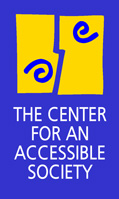
DISABILITY
ISSUES
INFORMATION
FOR
JOURNALISTS
ABOUT
THE CENTER
Access to information to bloom as rules take effect
Note to readers: links to news articles may not work after a few weeks, as news media remove current stories to their archives. The link may take you to the archives section, where, for a fee, you can view the article.
June 19, 2001 -- After Thursday, rules for access to information become mandatory throughout the federal government. New information kiosks at national parks, for example, must have an alternate method of providing information - such as audio prompts - in addition to a touch screen; but most news of this change has focused on Internet access. Federal websites must be accessible to people who use screen readers and other alternate forms of using the Internet.
June 21 is the day rules for ensuring compliance with Section 508 of the Rehabilitation Act and the WorkForce Investment Act of 1998 take effect (for an overview, go to http://www.accessiblesociety.org/topics/webaccess/index.htm). The law applies to all Federal agencies when they develop, procure, maintain, or use electronic and information technology -- so software manufacturers are starting to release accessible versions as well.
For overviews of the change, the May 21 Federal Computer Week article (http://www.fcw.com/fcw/articles/2001/0521/cov-508-05-21-01.asp) is good; and although it's dated, still one of the best pieces on the problems of an inaccessible Internet is reporter Judy Heim's report about online accessibility in the September, 2000 PC World online at http://www.pcworld.com/features/article.asp?aid=17690
The web seems to be proliferating with sites on "how to make your site accessible" -- some of the better ones we've seen are from the National Arts and Disabilities Center at UCLA (http://nadc.ucla.edu/dawpi.htm) and the National Parks Services' site, which has a number of links to valuable accessibility resources including simplified version of the guidelines at http://www.nps.gov/access/target.htm For an overview that includes a link to let you see how YOUR web page looks to a screen reader, go to http://www.delorie.com/web/lynxview.html The University of Wisconsin/Madison's Division of Information Technology (http://wiscinfo.doit.wisc.edu/ltde/access/ewers.htm) offers a video showing how a screen reader works. If you're a web developer, JAWS For Windows has a trial version you can download to test how your site sounds to text-to-voice screen readers, at http://www.hj.com/JAWS/JAWS.html And Bobby, a free service provided by the Center for Applied Special Technology, can help web page authors identify and repair significant barriers to access by individuals with disabilities.
For the federal overview, visit the Federal Information Technology Accessibility Initiative at http://www.section508.gov/
The document "How Civil Rights For People With Disabilities Impact The Private Sector" is available on the website of the International Center for Disability Resources on the Internet, at http://www.icdri.org/how_civil_rights_for_people_with.htm
And be sure to visit the web access page at the Center for An Accessible Society at http://www.accessiblesociety.org/topics/webaccess/index.htm